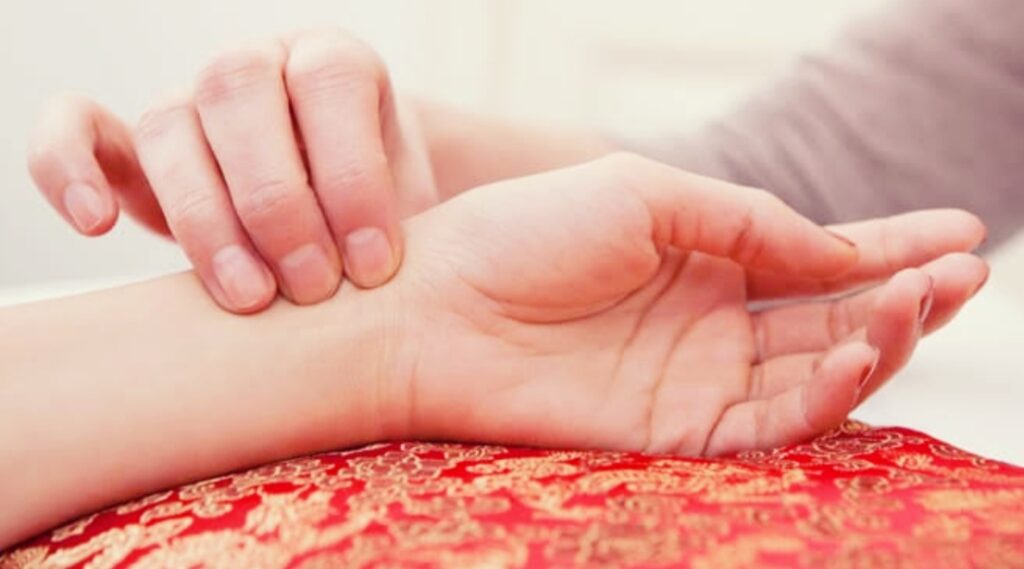Pulse Diagnosis in Ayurveda is among the most fascinating ways of monitoring interactions in the body. It is an ancient Ayurvedic technique of diagnoses through reading the pulse. It is a non-invasive technique of Ayurveda that helps the practitioners to find the root cause of the disease and not just address the symptoms. This technique is known as “Pulse Diagnosis” or “Nadi Pariksha”.

The concept of Nadi Pariksha is found in the books of Sharangdhar Samhita in the 13th century. thehighlights the correlation between the Nadi (energy system) and Tridosha (three doshas).
This precise Ayurvedic knowledge can help an Ayurvedic physician to recognize the disease process before the symptoms are overtly visible. Pulse is known as “Nadi” in Ayurveda. Nadi is the Sanskrit word used for channel, pipe or tube through which cell intelligence vibrates.
Through the technique of Pulse Diagnosis, subtle things are read at seven different levels that help the physician in ascertaining the condition of various functions in the body.
Through the use of Pulse Diagnosis, the Ayurveda physician can determine:
- The physical and mental constitution of the patient
- The dominant dosha in an individual
- Any imbalance in the doshas
- The movement and state of the doshas
- The movement of sub-doshas
- The movement of toxins in the body
- The strength of agni (digestive fire)
- The existence of any tissue degeneration
- Any abnormal physical or mental activity
How Pulse Diagnosis is done?
The Ayurvedic physician places three fingers on the right or left hand of the patient below the wrist. In this way, he can feel the blood flowing in squirts during the expansion and contraction of the heart. This Hasta Nadi (radial pulse) is the ideal pulse for complex pulse measurements.
In Ayurveda, it is mentioned that there are three types of pulse. These are:
- Vata Pulse: The Vata pulse is felt under the index finger.
- It can be determined by a thin, fast and irregular rhythm under the skin.
- The Vata pulse is cold, light, dry, hard, moving, strong, thin and rough.
- It is often compared to the movement of a snake.
- Pitta Pulse: The Pitta pulse is taken under the middle finger.
- The pitta pulse is stronger and more voluminous. It may have a regular or irregular rhythm.
- The balanced Pitta pulse feels hot, quick, dynamic and regular just like a hopping frog.
- Kapha Pulse: The Kapha pulse is located under the ring finger.
- The Kapha pulse is felt deeper down (under fatty tissue) and it moves in a regular way and slowly.
- The balanced Kapha pulse is subtle, slow, soft and viscous in nature.
- It is similar to a swan moving on water.
There are four parameters that help the practitioner to categorize a person’s constitutional type. These are:
- Pulse Rate
- Pulse Rhythm
- Pulse Intensity
- Pulse Volume
| Vata | Pitta | Kapha | |
| Pulse Rate | Quick | Moderate | Slow |
| Pulse Rhythm | Irregular | Relatively Regular | Very Regular |
| Pulse Intensity | Variable | Strong | Weak |
| Pulse Volume | Low | Medium | High |
The Ayurvedic physician can feel the pulse at other body parts as well, thereby gaining a very complete picture of the state of overeall health of the patient.
The Pulse at Different Levels:
In an in-depth Ayurvedic pulse diagnosis, the Ayurvedic expert can draw accurate conclusions about the patient’s physical as well as mental health.
The physical examination via the pulse allows the Ayurvedic physician to observe the progress of the patient’s healing as well even if there are no other apparent signs of improvement.
Pulse diagnosis is also useful for early detection of conditions, even those that are just starting to develop. Thus, it is a useful tool to prevent illnesses before they take root.
What is the best time to check a patient’s pulse?
The early morning is considered as the best time to take the pulse of the patient, but not right after the patient has just awakened.
In addition, a patient’s pulse should also not be taken right after a meal, after physical exercise, right after taking bath and after having meals.
The patient should also not be hungry, thirsty or angry or in a traumatised state of shock.
Thus, pulse diagnosis can detect imbalances and potential diseases giving one the opportunity to correct them before they affect the quality of life and it is always a fundamental part of Ayurvedic system of medicine.
Disclaimer:-
This article is not a substitute to the standard Medical Diagnosis or personalized Ayurvedic Treatment! It is intended only for Information!
For experts consultation, please write us at care@blessayurveda.com.
2,506 total views, 2 views today